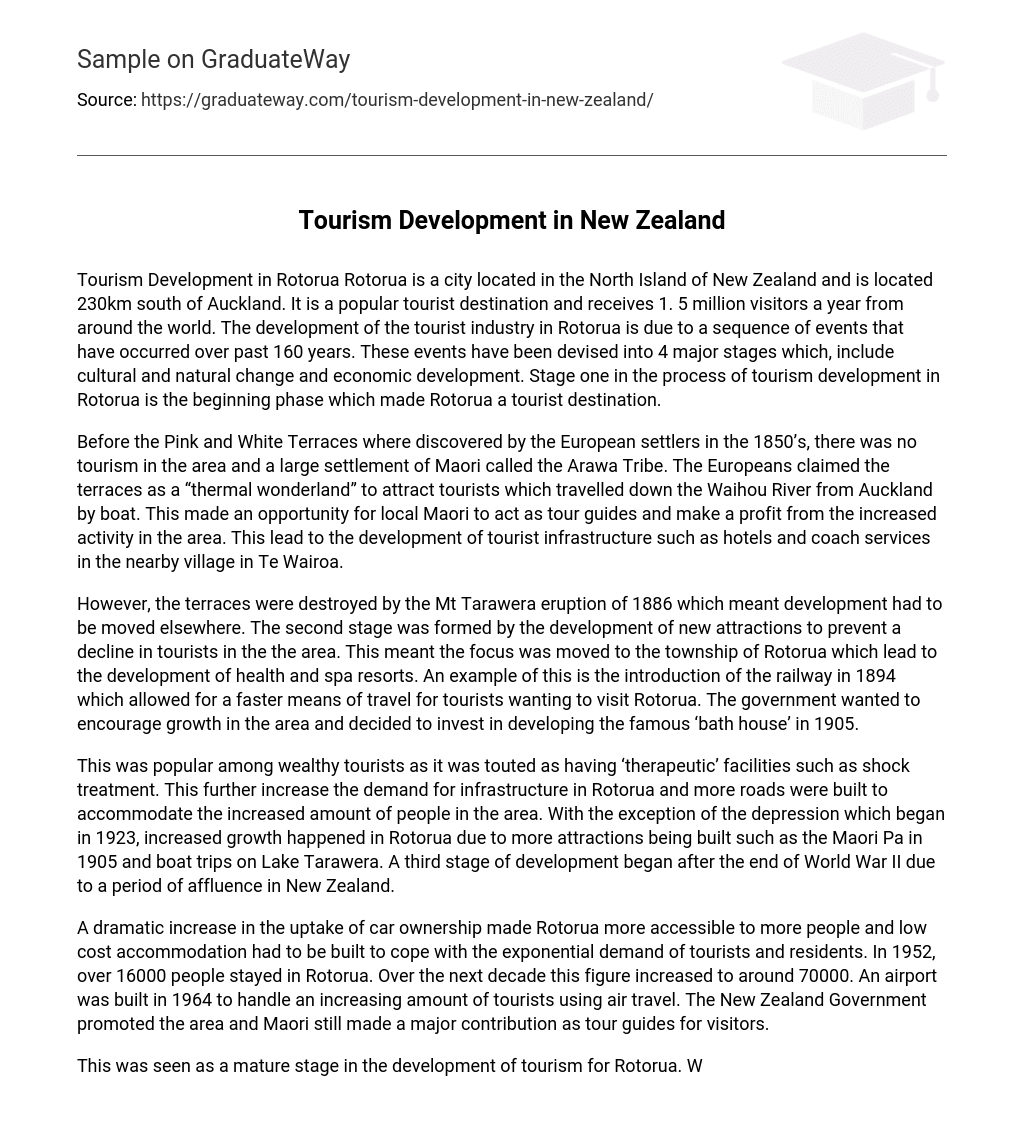Tourism Development in Rotorua Rotorua is a city located in the North Island of New Zealand and is located 230km south of Auckland. It is a popular tourist destination and receives 1. 5 million visitors a year from around the world. The development of the tourist industry in Rotorua is due to a sequence of events that have occurred over past 160 years. These events have been devised into 4 major stages which, include cultural and natural change and economic development. Stage one in the process of tourism development in Rotorua is the beginning phase which made Rotorua a tourist destination.
Before the Pink and White Terraces where discovered by the European settlers in the 1850’s, there was no tourism in the area and a large settlement of Maori called the Arawa Tribe. The Europeans claimed the terraces as a “thermal wonderland” to attract tourists which travelled down the Waihou River from Auckland by boat. This made an opportunity for local Maori to act as tour guides and make a profit from the increased activity in the area. This lead to the development of tourist infrastructure such as hotels and coach services in the nearby village in Te Wairoa.
However, the terraces were destroyed by the Mt Tarawera eruption of 1886 which meant development had to be moved elsewhere. The second stage was formed by the development of new attractions to prevent a decline in tourists in the the area. This meant the focus was moved to the township of Rotorua which lead to the development of health and spa resorts. An example of this is the introduction of the railway in 1894 which allowed for a faster means of travel for tourists wanting to visit Rotorua. The government wanted to encourage growth in the area and decided to invest in developing the famous ‘bath house’ in 1905.
This was popular among wealthy tourists as it was touted as having ‘therapeutic’ facilities such as shock treatment. This further increase the demand for infrastructure in Rotorua and more roads were built to accommodate the increased amount of people in the area. With the exception of the depression which began in 1923, increased growth happened in Rotorua due to more attractions being built such as the Maori Pa in 1905 and boat trips on Lake Tarawera. A third stage of development began after the end of World War II due to a period of affluence in New Zealand.
A dramatic increase in the uptake of car ownership made Rotorua more accessible to more people and low cost accommodation had to be built to cope with the exponential demand of tourists and residents. In 1952, over 16000 people stayed in Rotorua. Over the next decade this figure increased to around 70000. An airport was built in 1964 to handle an increasing amount of tourists using air travel. The New Zealand Government promoted the area and Maori still made a major contribution as tour guides for visitors.
This was seen as a mature stage in the development of tourism for Rotorua. With this rapid development, locals were noticing in increase in environmental impact from tourists such as more litter and pollution. With an increasing amount of international tourists visiting Rotorua and heavy promotion of the area by the government, a forth stage was created in tourism development for the area. This lead to the redevelopment of existing areas to make them more appealing to an international audience.
This included the $35m in improving historic buildings and $21m on revitalizing the lake front. As the traditional market becames saturated with growth and investment, more upmarket hotels were also constructed for visitors as well as more adventure activities for free and independent tourists (FIT’S) such as Skyline Skyrides in 1985 (the first adventure tourism venue in Rotorua). In conclusion, these four stages have lead to the development of one of the most popular destinations in New Zealand which receives over 1. m visitors annually. An increased amount of attractions have helped stopped a decline in tourists and helps boost the local economy by adding jobs and better infrastructure. This can have a positive and negative impact on locals. Better infrastructure gives locals better access to essential services and jobs provide an income for families. However, increased tourism can lead to environmental impacts such as pollution which can spoil the natural attractions the tourists themselves visit. 736 Words





